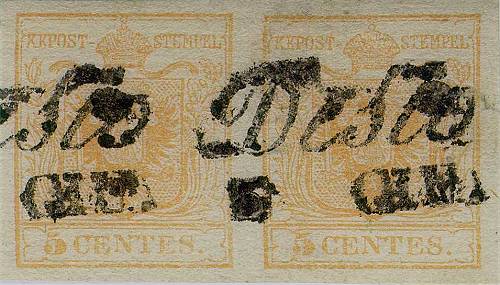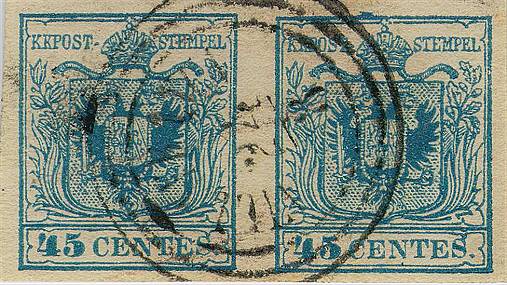Between
the multiple elements that characterize and differentiate the first issue
stamps in the various printing runs there is the horizontal spacing between
the pieces. It's another detail that allows for a correct classification of
the stamp type and of its composition.
At the beginning the average horizontal spacing between two pieces was around
2.5 mm and later on, probably to simplify the separation with the scissors
made by the postal workers, it was increased to around 3.0 mm. The larger
spacing was recovered by decreasing the group inter-space that went from 24
mm to around 14.5 mm (it was therefore shrunk even beyond the necessary...).
More constant was instead the vertical spacing that was only slightly revisited
going from 3.20 mm to around 3.0 mm. The stamps with the first spacing type
are called with "narrow spacing" while the following ones
with "large spacing".
I summarize here below the spacing type present for each value:
| Stamp |
Spacing
|
| 5 centesimi |
Narrow
|
| 10 centesimi - handmade paper |
Narrow
|
| 10 centesimi - macchine made paper |
Large
|
| 15 centesimi - 1st type |
Narrow
|
| 15 centesimi - 2nd type |
Narrow
|
| 15 centesimi - 3rd type - handmade paper |
Large
|
| 15 centesimi - 3rd type - macchine made paper |
Large
|
| 15 centesimi - ribbed paper - 1st and 2nd type |
Narrow
|
| 15 centesimi - 3rd type - laid paper |
Large
|
| 30 centesimi - 1st type |
Narrow
|
| 30 centesimi - 2nd type - handmade paper |
Narrow
& large
|
| 30 centesimi - 2nd type - machine made paper |
Large
|
| 30 centesimi - 1st type - ribbed paper |
Narrow
|
| 45 centesimi - 1st type |
Narrow
|
| 45 centesimi - 2nd type - slate - handmade paper |
Narrow
|
| 45 centesimi - 2nd type - blue - handmade paper |
Large
|
| 45 centesimi - 2nd type - machine made paper |
Large
|
| 45 centesimi - 1st type - ribbed paper |
Narrow
|
Here below I show two beautiful couples, one of the 5 centesimi with narrow spacing (Fig. 1) and one of the 45 centesimi with large spacing (Fig. 2). The difference is quite visible even if we are dealing with only half millimeter.

Fig. 1:
narrow spacing

Fig. 2:
large spacing